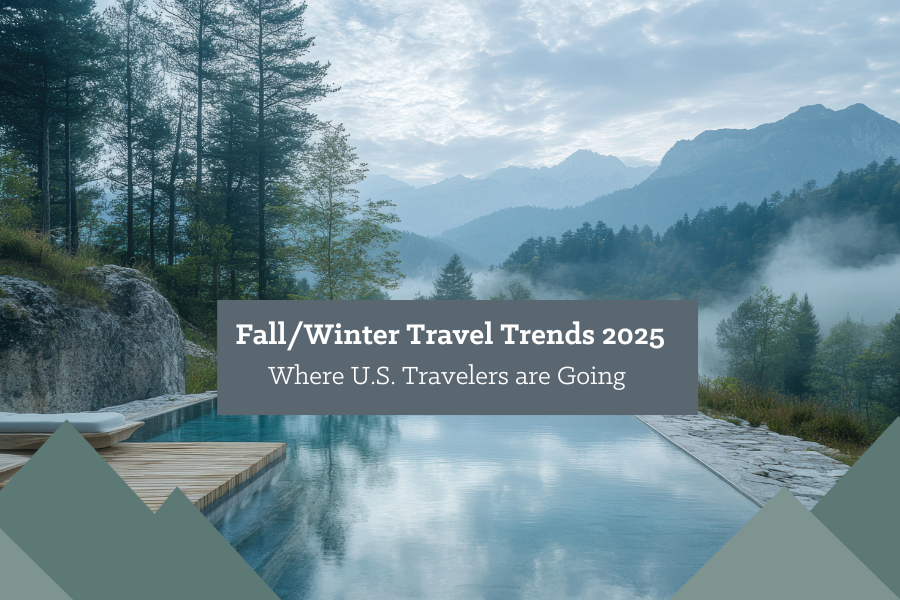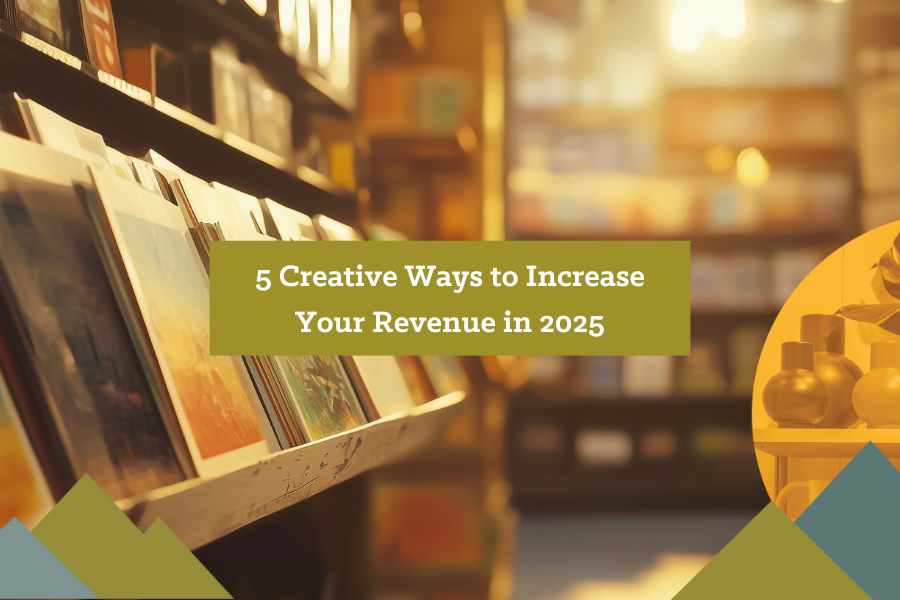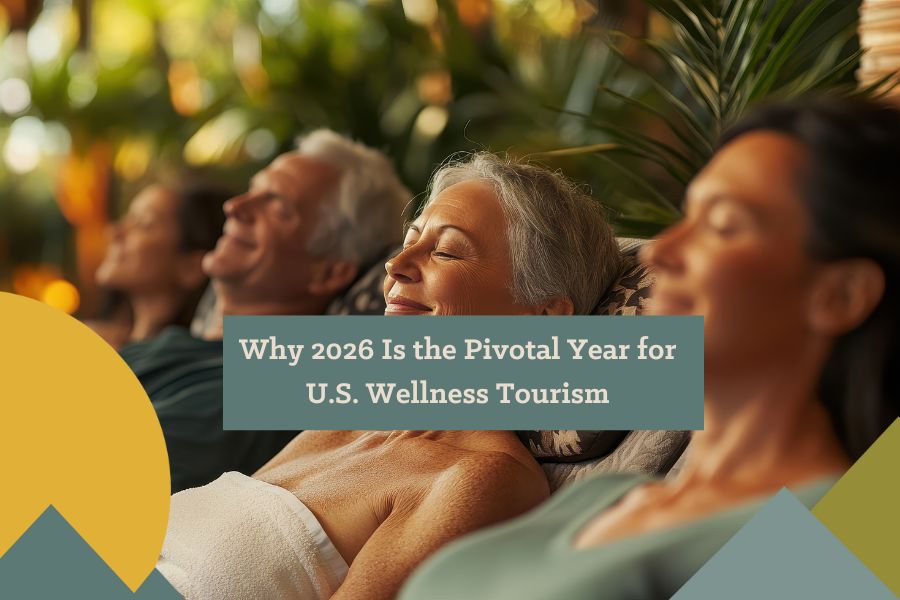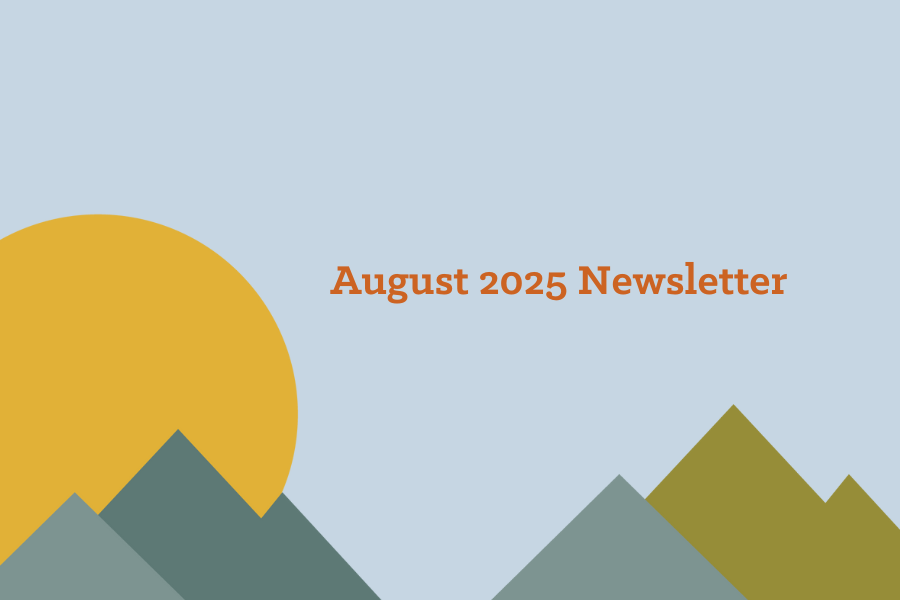Americans are just traveling more than ever—they’re getting smarter about it. In fact, more than 119 million Americans traveled 50+ miles during the 2024 holiday season, smashing the all-time record set in 2019. But here’s the kicker: they’re not just running away from winter anymore. Instead, travelers are actively chasing it down for experiences you simply can’t get any other time of year.
This isn’t your typical seasonal migration story. We’re seeing a fundamental shift toward what we’re calling “experiential seasonality”—where travelers are picking destinations specifically because of what winter or fall brings to the table, not despite it.
Where Americans Are Heading
If you think you know where people are going for fall and winter travel, think again. Sure, there are the usual suspects, but the real story is in how travelers are choosing these destinations—and why. Fall foliage destinations are absolutely crushing it, with a 28% annual increase in vacation rental searches for September through November trips. But this isn’t just about pretty leaves. People are timing entire vacations around natural phenomena, harvest festivals, and seasonal celebrations that you can’t experience any other time of year.
Traditional Winter Sun Still Rules
Let’s be honest—Florida still owns winter travel, with four cities landing in the top 10: Orlando, Key West, Miami Beach, and Fort Lauderdale. Take Disney World, which completely transforms from November 14 through December 31, 2025, rolling out holiday entertainment, themed food, and festive character experiences that make a winter Disney trip feel completely different from a summer visit. It’s not just a theme park vacation—it’s a winter experience that happens to be at a theme park.
The Unexpected Winners
Phoenix is having a moment, especially for winter escapes. People are figuring out that Arizona isn’t just about heat—it’s about crystal-clear skies perfect for stargazing, perfect temperatures for hiking, and a wellness vibe that feels restorative rather than rushed. Meanwhile, from Bellingham to Bend, the Pacific Northwest is quietly becoming a shoulder season favorite as travelers discover that fall and early winter mean dramatic scenery, smaller crowds, and hotel rates that won’t make you cry.
Hot springs are also becoming the secret destination of winter road trips. Places like California’s Sierra Nevada are seeing huge upticks in winter visitors who are building entire trips around soaking experiences. Grover Hot Springs State Park keeps their pools at a perfect 102-105 degrees year-round, while Sierra Hot Springs Resort offers both indoor and outdoor soaking with special winter rates from November through April. It’s the kind of experience that makes you wonder why anyone would want to visit a hot spring when it’s already hot outside.
Weather as a Planning Tool, Not an Obstacle
Here’s something travel pros are calling “climate-conscious routing”—and it’s exactly what it sounds like. With potential La Niña conditions hitting around October, smart travelers know the Pacific Northwest and Great Lakes regions will be wetter than usual, while the South stays drier and warmer. Instead of fighting the weather, they’re working with it. 44% of travelers are already choosing destinations closer to home because of rising costs, but they’re discovering that “closer” doesn’t mean “boring”—it means finding incredible seasonal experiences within driving distance.
The Rise of Intentional and Wellness-Focused Travel
Remember “revenge travel”? Yeah, that’s over. The biggest shift happening right now is travelers ditching the FOMO approach for what experts are calling JOMO—the joy of missing out. People are moving away from the old mindset of cramming every possible destination into their Instagram feed. Instead, they’re picking fewer places and staying longer, choosing experiences that actually mean something to them.
Intentional Travel Movement
2025 is officially the year of intentional travel — travelers want a slower pace and they’re not apologizing for it. This shows up in everything from longer stays at fewer destinations to trips planned entirely around specific seasonal events. People are booking vacations for apple harvest season, winter solstice celebrations, and regional holiday traditions that become the main event, not just something to do while you’re there. The focus has completely flipped from capturing the perfect social media moment to creating experiences that actually matter to the traveler.
Winter Wellness Tourism
Want to know what’s really taking off? Digital detox travel and nature-focused destinations where people can actually disconnect from the chaos of daily life. Winter wellness tourism is exploding because travelers are realizing that cold weather offers something summer can’t: the perfect excuse to slow down and reset.
Four Seasons mountain resorts are reporting record winter wellness bookings, combining luxury stays with spa treatments designed specifically for skiers. Winter Park Resort’s Zephyr Mountain Lodge gives you ski-in/ski-out access plus heated underground parking and on-site relaxation spots—because nothing says “I’ve got my life together” like skiing to your front door. Even luxury ski destinations like Four Seasons Whistler are getting creative with winter-specific experiences, including Moët & Chandon après setups and spa treatments designed for cold-weather recovery.
Seasonal Experience Seeking
Here’s a stat that might surprise you: 68% of travelers prefer adventure-based vacations like hiking, scuba diving, and cultural immersion. But the really interesting part? They’re not waiting for summer to do it. People are actively hunting down winter hiking, ice climbing, and aurora viewing experiences—adventures you literally cannot have any other time of year.
Repositioning cruises have become the insider secret for fall and winter travel. These are the voyages where cruise lines move ships between seasonal destinations, offering discounted rates on absolutely unique itineraries. Princess Cruises has a 20-day Panama Canal starting at $2,227 per person—try finding that kind of value on a regular cruise. Or there’s Celebrity Edge’s trips designed to perfect for travelers who want extended luxury with multiple sea days and exotic port calls that aren’t on anyone’s typical cruise radar.
The Economics: High-End vs. Budget Travel
Here’s what’s fascinating about fall and winter travel spending: people are simultaneously going all-out on experiences they care about while getting incredibly strategic about where they save money. The average 2025 travel budget hit $10,244, which is nearly double what people spent in 2024. That’s not a typo. People are prioritizing travel like never before, but they’re also getting smarter about how they spend.
Premium Experience Investment
When travelers find something they really want, price becomes almost irrelevant. Music fans will pay 25% more for hotels and flights to catch their favorite artist, while sports fans willingly pay 31% more for hotels and 28% more for flights to see games live. This “premium for experience” mindset is reshaping seasonal travel.
Take luxury ski properties—places like Hotel Lodge at Vail are charging rates that would make summer resort owners jealous, and people are paying it because you can’t ski in July. Courchevel’s Hôtel Barrière Les Neiges just debuted a two-story restaurant that transforms into a DJ party spot by night, turning the entire property into a complete seasonal destination. Even Disney World is getting creative with up-to-20% savings on room packages for October through December 2025 stays, showing how even premium brands create seasonal value.
Budget-Conscious Seasonal Strategies
On the flip side, travelers are getting seriously strategic about saving money. 9 out of 10 holiday travelers are hitting the road instead of flying, giving families complete control over transportation costs while extending their trips. Vacation rentals are becoming the go-to for longer winter stays because you get the space families need plus kitchen access to avoid eating out for every meal.
Smart properties are rewarding this trend with clever pricing. Sun Peaks offers 20% early bird savings for bookings made before August 31, 2025. Massanutten Resort has tiered discounts where 3-4 nights gets you 10% off, 5-6 nights earns 15% off, and a full week scores 20% off. It’s like they’re rewarding you for actually wanting to relax instead of rushing through a long weekend.
Spending Pattern Evolution
Here’s something interesting: 73% of travelers say supporting local small businesses is important when they visit new destinations. This isn’t just feel-good talk—it’s becoming a real budget line item, especially during fall and winter travel when seasonal farmers’ markets, local craft fairs, and regional food specialties become central to the travel experience rather than optional add-ons. People are budgeting specifically to shop local because it feels authentic in a way that generic souvenir shops never will.
Technology Enhancing Seasonal Travel Planning
U.S. travelers are no strangers to using technology to manage every part of their trip, but seasonal travel planning has taken things to a whole new level. 80% of younger travelers are using travel apps and social media to plan their perfect seasonal getaway, but honestly, the tech tools available now make everyone look like a travel planning genius.
Smart Seasonal Planning
Weather prediction apps and AI recommendations are completely changing how people approach seasonal trips. Instead of crossing your fingers and hoping for the best, travelers are using tools that predict optimal foliage timing, track storm patterns that might mess with winter travel plans, and give real-time updates on conditions at their destinations. 83% of travelers say at least one aspect of AI is useful for booking, and seasonal recommendations are among the most popular features. It’s like having a personal meteorologist and travel agent rolled into one app.
Digital Tools for Seasonal Experiences
Virtual reality previews are becoming particularly valuable for winter destinations and seasonal activities, allowing travelers to experience snow conditions, visualize winter landscapes, and understand activity requirements before booking. Mobile booking platforms are enabling last-minute seasonal travel decisions, particularly important for weather-dependent activities like aurora viewing or optimal foliage timing where conditions can change rapidly.
Technology-Enabled Personalization
Travelers have noted that the best usage of generative AI is activity recommendations, budget/expense management, translation assistance, and personalized trip recommendations. For seasonal travel, this personalization becomes particularly valuable as travelers seek experiences that align with their specific interests in seasonal phenomena, weather preferences, and activity levels during different times of the year. Technology is enabling more sophisticated seasonal travel planning, from apps that predict optimal foliage timing to AI-powered recommendations that suggest activities based on real-time weather conditions and personal preferences.
2025 Is All About Experiences
Fall and winter 2025 travel isn’t just about escaping the cold anymore—it’s about embracing what these seasons uniquely offer. The shift toward intentional travel, wellness experiences, and technology-enhanced planning is creating real opportunities for tourism businesses that understand this evolution. Whether travelers are splurging on a luxury ski lodge experience or strategically road-tripping to hot springs destinations, the common thread is purposefulness. They’re not just enduring winter; they’re actively choosing it for experiences they can’t get any other time.
With U.S. travel spending projected to hit $1.35 trillion in 2025, businesses that get this trend right will be the ones thriving. The data shows travelers are willing to invest serious money in meaningful seasonal experiences while also seeking authentic connections with local communities and natural phenomena. As we move through 2025, fall and winter travel represents something bigger than just bouncing back from the pandemic—it’s a complete reimagining of what seasonal travel can be when people actually plan for the season instead of despite it.
To keep up to date on the latest trends influencing travel and tourism, subscribe to our newsletter. To find products that your visitors and guests will love, register for our next event.








